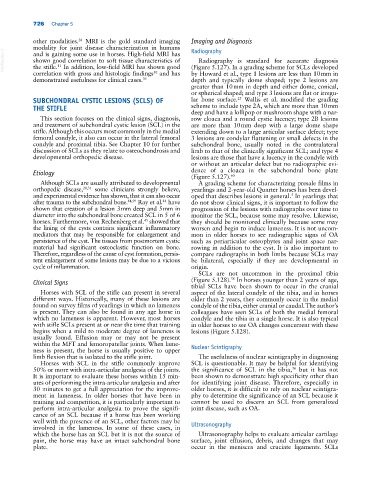Page 760 - Adams and Stashak's Lameness in Horses, 7th Edition
P. 760
726 Chapter 5
other modalities. MRI is the gold standard imaging Imaging and Diagnosis
38
modality for joint disease characterization in humans Radiography
VetBooks.ir shown good correlation to soft tissue characteristics of (Figure 5.127). In a grading scheme for SCLs developed
and is gaining some use in horses. High‐field MRI has
Radiography is standard for accurate diagnosis
the stifle. In addition, low‐field MRI has shown good
11
50
correlation with gross and histologic findings and has by Howard et al., type 1 lesions are less than 10 mm in
demonstrated usefulness for clinical cases. 35 depth and typically dome shaped; type 2 lesions are
greater than 10 mm in depth and either dome, conical,
or spherical shaped; and type 3 lesions are flat or irregu-
SUBCHONDRAL CYSTIC LESIONS (SCLS) OF lar bone surface. Wallis et al. modified the grading
25
THE STIFLE scheme to include type 2A, which are more than 10 mm
deep and have a lollipop or mushroom shape with a nar-
This section focuses on the clinical signs, diagnosis, row cloaca and a round cystic lucency; type 2B lesions
and treatment of subchondral cystic lesion (SCL) in the are more than 10 mm deep with a large dome shape
stifle. Although this occurs most commonly in the medial extending down to a large articular surface defect; type
femoral condyle, it also can occur in the lateral femoral 3 lesions are condylar flattening or small defects in the
condyle and proximal tibia. See Chapter 10 for further subchondral bone, usually noted in the contralateral
discussion of SCLs as they relate to osteochondrosis and limb to that of the clinically significant SCL; and type 4
developmental orthopedic disease. lesions are those that have a lucency in the condyle with
or without an articular defect but no radiographic evi-
Etiology dence of a cloaca in the subchondral bone plate
(Figure 5.127). 60
Although SCLs are usually attributed to developmental A grading scheme for characterizing presale films in
orthopedic disease, 28,31 some clinicians strongly believe, yearlings and 2‐year‐old Quarter horses has been devel-
and experimental evidence has shown, that it can also occur oped that describes lesions in general. In yearlings that
5
after trauma to the subchondral bone. 44,59 Ray et al. have do not show clinical signs, it is important to follow the
44
shown that creation of a lesion 3 mm deep and 5 mm in progression of the lesions with radiographs over time to
diameter into the subchondral bone created SCL in 5 of 6 monitor the SCL, because some may resolve. Likewise,
horses. Furthermore, von Rechenberg et al. showed that they should be monitored clinically because some may
45
the lining of the cysts contains significant inflammatory worsen and begin to induce lameness. It is not uncom-
mediators that may be responsible for enlargement and mon in older horses to see radiographic signs of OA
persistence of the cyst. The tissues from postmortem cystic such as periarticular osteophytes and joint space nar-
material had significant osteoclastic function on bone. rowing in addition to the cyst. It is also important to
Therefore, regardless of the cause of cyst formation, persis- compare radiographs in both limbs because SCLs may
tent enlargement of some lesions may be due to a vicious be bilateral, especially if they are developmental in
cycle of inflammation. origin.
SCLs are not uncommon in the proximal tibia
56
Clinical Signs (Figure 5.128). In horses younger than 2 years of age,
tibial SCLs have been shown to occur in the cranial
Horses with SCL of the stifle can present in several aspect of the lateral condyle of the tibia, and in horses
different ways. Historically, many of these lesions are older than 2 years, they commonly occur in the medial
found on survey films of yearlings in which no lameness condyle of the tibia, either cranial or caudal. The author’s
is present. They can also be found in any age horse in colleagues have seen SCLs of both the medial femoral
which no lameness is apparent. However, most horses condyle and the tibia in a single horse. It is also typical
with stifle SCLs present at or near the time that training in older horses to see OA changes concurrent with these
begins when a mild to moderate degree of lameness is lesions (Figure 5.128).
usually found. Effusion may or may not be present
within the MFT and femoropatellar joints. When lame- Nuclear Scintigraphy
ness is present, the horse is usually positive to upper
limb flexion that is isolated to the stifle joint. The usefulness of nuclear scintigraphy in diagnosing
Horses with SCL in the stifle commonly improve SCL is questionable. It may be helpful for identifying
50% or more with intra‐articular analgesia of the joints. the significance of SCL in the tibia, but it has not
56
It is important to evaluate these horses within 15 min- been shown to demonstrate high specificity other than
utes of performing the intra‐articular analgesia and after for identifying joint disease. Therefore, especially in
30 minutes to get a full appreciation for the improve- older horses, it is difficult to rely on nuclear scintigra-
ment in lameness. In older horses that have been in phy to determine the significance of an SCL because it
training and competition, it is particularly important to cannot be used to discern an SCL from generalized
perform intra‐articular analgesia to prove the signifi- joint disease, such as OA.
cance of an SCL because if a horse has been working
well with the presence of an SCL, other factors may be Ultrasonography
involved in the lameness. In some of these cases, in
which the horse has an SCL but it is not the source of Ultrasonography helps to evaluate articular cartilage
pain, the horse may have an intact subchondral bone surface, joint effusion, debris, and changes that may
plate. occur in the meniscus and cruciate ligaments. SCLs

